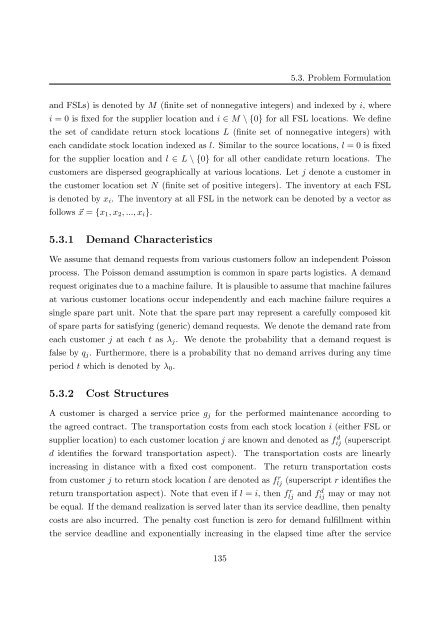Customer Information Driven After Sales Service ... - RePub
Customer Information Driven After Sales Service ... - RePub
Customer Information Driven After Sales Service ... - RePub
You also want an ePaper? Increase the reach of your titles
YUMPU automatically turns print PDFs into web optimized ePapers that Google loves.
5.3. Problem Formulation<br />
and FSLs) is denoted by M (finite set of nonnegative integers) and indexed by i, where<br />
i = 0 is fixed for the supplier location and i ∈ M \{0} for all FSL locations. We define<br />
the set of candidate return stock locations L (finite set of nonnegative integers) with<br />
each candidate stock location indexed as l. Similar to the source locations, l =0isfixed<br />
for the supplier location and l ∈ L \{0} for all other candidate return locations. The<br />
customers are dispersed geographically at various locations. Let j denote a customer in<br />
the customer location set N (finite set of positive integers). The inventory at each FSL<br />
is denoted by xi. The inventory at all FSL in the network can be denoted by a vector as<br />
follows �x = {x1,x2, ..., xi}.<br />
5.3.1 Demand Characteristics<br />
We assume that demand requests from various customers follow an independent Poisson<br />
process. The Poisson demand assumption is common in spare parts logistics. A demand<br />
request originates due to a machine failure. It is plausible to assume that machine failures<br />
at various customer locations occur independently and each machine failure requires a<br />
single spare part unit. Note that the spare part may represent a carefully composed kit<br />
of spare parts for satisfying (generic) demand requests. We denote the demand rate from<br />
each customer j at each t as λj. We denote the probability that a demand request is<br />
false by qj. Furthermore, there is a probability that no demand arrives during any time<br />
period t which is denoted by λ0.<br />
5.3.2 Cost Structures<br />
A customer is charged a service price gj for the performed maintenance according to<br />
the agreed contract. The transportation costs from each stock location i (either FSL or<br />
supplier location) to each customer location j are known and denoted as f d ij (superscript<br />
d identifies the forward transportation aspect). The transportation costs are linearly<br />
increasing in distance with a fixed cost component. The return transportation costs<br />
from customer j to return stock location l are denoted as f r lj (superscript r identifies the<br />
return transportation aspect). Note that even if l = i, thenfr lj and f d ij may or may not<br />
be equal. If the demand realization is served later than its service deadline, then penalty<br />
costs are also incurred. The penalty cost function is zero for demand fulfillment within<br />
the service deadline and exponentially increasing in the elapsed time after the service<br />
135

















